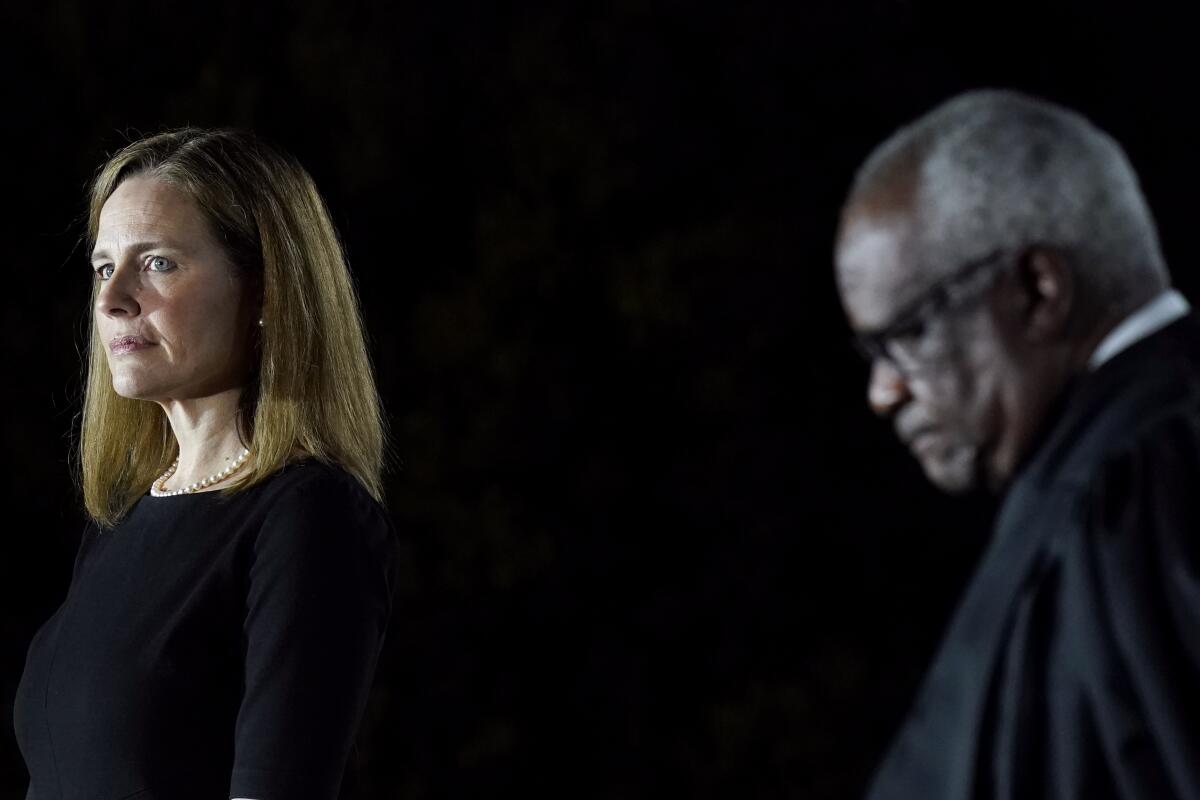Column: Supreme Court’s conservatives tip their hand with Arizona case

- Share via
As rulings rolled out over the last month, some Supreme Court watchers concluded that the feared hyper-conservative, Trump-weighted court was instead turning out to be a kinder and gentler center-right body.
Don’t believe it.
Where some saw hints of moderation in this term’s initial decisions, a closer look shows a foundation for future shifts to the right. Any doubt of this leaning should be erased by two decisions Thursday in which a lockstep bloc of six conservative justices handed clear victories to Republican causes.
Most important, the court in Brnovich vs. Democratic National Committee sharply curtailed Section 2 of the Voting Rights Act, which has been used against voting restrictions that disproportionately target minority voters. The opinion, by Justice Samuel A. Alito Jr., allows the controversial out-of-precinct policy to discard ballots and permits a ban on “ballot harvesting.”
The court had already gutted the more potent Section 5 eight years ago in the Shelby County case, and Senate Republicans have been united in opposition to any voting rights legislation — meaning the Brnovich decision weakens nearly the only remaining tool for challenging the wave of draconian restrictions in red states.
The second major decision to confirm the court’s rightward shift came in Americans for Prosperity Foundation vs. California Atty. Gen. Rob Bonta. On Thursday, the court delivered another solid victory to the conservative cause by striking down California’s attempt to force organizations to reveal the identities of their major donors.
Those who saw signs of moderation before these decisions were misinterpreting two other closely watched cases. California vs. Texas and Fulton vs. Philadelphia could have, respectively, killed the Affordable Care Act and broadly privileged the free exercise of (conservative) religious rights over (gay couples’) civil rights. But that didn’t happen.
Is the weight of the job tempering the conservative instincts of Trump appointees Neil M. Gorsuch, Brett M. Kavanaugh and Amy Coney Barrett? Hardly.
First, in arriving at the relatively anodyne outcomes of Fulton vs. Philadelphia and California vs. Texas, the new conservatives gave up nothing.
When an earlier generation of Republican appointees — Sandra Day O’Connor, David Souter and Anthony Kennedy — showed they were mellowing into a moderate bloc, they took an unequivocal stance by reaffirming the core holding of Roe vs. Wade. Their reasoning in Planned Parenthood vs. Casey in 1992 committed the court to Roe as “super-precedent.” Such moments pushed the law forward decisively (and conservatism lost). Not so with the court’s decisions last .
In Fulton vs. Philadelphia, the progressives, joined by Chief Justice John G. Roberts Jr., merely stretched current doctrine to find that in this one instance, Philadelphia had discriminated against religion by requiring a Catholic adoption agency to work with gay couples. The decision didn’t require the justices to endorse or reject the principle, established in a 1990 opinion by Antonin Scalia, that the state may “burden religion” — that is, rein in its free exercise — if done through a neutral and generally applicable law.
In other words, the Fulton decision in no way hems in conservatives who want to overrule Scalia’s precedent and establish a primacy among 1st Amendment rights for religious exercise. The table is still set for such an outcome, which would be a conservative revolution in the law.
Other rulings this term — especially one that allowed church gatherings to continue during the pandemic despite state public health orders — give every indication that the new conservatives are eager for just such a sea change.
Like the Fulton decision that avoided any binding commitments, the Obamacare case was decided narrowly, on the basis of standing. The ACA survived, but not because a burgeoning, reasonable moderate majority put the court firmly on the side of the broader legal and social culture, where Obamacare is a fixture. It survived because a thin majority agreed on a side issue.
There were also several cases pushing the law to the right in more arcane legal areas that are priorities for the Federalist Society crowd. For example, the Transunion case narrowed standing law and made it harder for Congress to provide suits for violations of federal law; the Cedar Point case broadened what counts as a physical taking by government; and the Collins case continued down the road of eliminating agency structures that protect officials from being removed by the president — protection that the court’s majority sees as unduly fettering executive power.
One can’t ignore those decisions in divining the court’s direction, nor should one interpret alliances in marginal cases as a bellwether of true ideological leanings. For that, look to the marquee decisions like those announced Thursday — and watch the looming abortion case in Mississippi that could present the court with a clean opportunity to overrule Roe vs. Wade. The right’s supermajority on the bench can now simply brush aside dissenting arguments.
The question is not whether the conservative justices will remake American law and society, but when and how.
More to Read
A cure for the common opinion
Get thought-provoking perspectives with our weekly newsletter.
You may occasionally receive promotional content from the Los Angeles Times.











